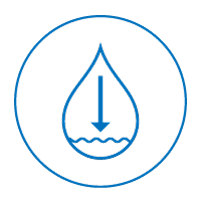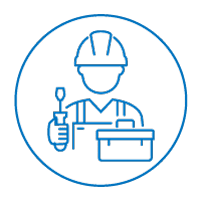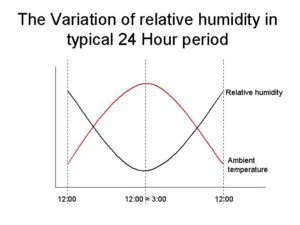Evaporative Cooling
Evaporative coolers use water evaporation to cool the air. This technique has been used in warmer climates for
many
years. As the effects of global warming are felt in Europe as well, the use of evaporative cooling is becoming
more
widespread. In ancient times, Arabs used to hang wet clothes to doors and windows to take advantage of air
cooling
through water evaporation. As the hot air passes to the wetted media (in this case the cloth), the water
evaporates
and
the heat in the air is absorbed, which lowers the air temperature.
Likewise, on days when heat causes discomfort, people often head off to lakes or the seaside in search of
relief.
Evaporative cooling is, in many ways, simulating the cooler conditions so often found near large expanses of
water.
How evaporative cooling works
Evaporative cooling units only use water to cool the air. No chemical refrigerants are involved in the process.
Moreover, Evaporative air conditioners use far less electricity compared to refrigerated systems: that all adds
up
to
very responsible environmental and energy saving characteristics.
No matter how hot it gets outside, evaporative coolers use the same amount of power and still deliver 100%
fresh,
cool
air inside. This is in direct contrast to refrigerated systems, which require increasing amounts of power as
outside
temperatures rise. Evaporative coolers’ cost-saving capabilities actually increase, when the heat is at its
highest.
At
the same time, their performance also increases as temperatures rise – again, in complete contrast to
refrigerated
systems.
Using little electricity, no compressor and with low running costs, evaporative cooling is the perfect solution
for
industrial and commercial environments, that often have no cooling system installed at all. Air conditioning is
not
a
viable option, because in warehouses or industrial plants, the capital and running costs would be extremely
prohibitive
for end-users.
Furthermore, evaporative coolers use 100% fresh outside air. Outside air ventilation is now globally
acknowledged as
a
core component of healthy and comfortable buildings. Evaporative cooling units bring 100% fresh air, never
recirculating
indoor air. This can be a great solution to improve Indoor Air Quality, as incoming air naturally pushes the
stale
air
outside of the building from doors, windows or extract system.
The benefits of evaporative air conditioning are plenty, there’s never been a better time to invest in an
evaporative
air conditioner which is simple to maintain and operate and offers superior product performance.
With energy prices escalating and summers typically involving heat waves, evaporative air conditioning offers a
significant and increasing edge on refrigerated cooling, when it comes to energy efficiency, healthier air flow,
performance and easy install and maintenance.

Cost-effective to run
The first thing that comes to mind when operating an air conditioner
is the running cost. With modern and innovative
evaporative cooling such as Breezair by Seeley International you can save you up to 82% on
cooling energy bills (1).

Low water Usage
Evaporative air conditioners use a small amount of water. A Breezair
evaporative air conditioner for example, uses
around 40 litres of water per day (2).
By checking water saving features in different evaporative coolers, you will find that
Breezair by Seeley International
offers a superior water distribution system, water quality monitoring and automatic water
drainage which results in
minimum water usage for maximum cooling power.

Easy maintenance
Regular service by a qualified contractor will ensure an evaporative
cooler continues to run at its peak efficiency and
maintain low evaporative running costs. Scheduling an evaporative cooling service can be
arranged through our network of
distributors.
Evaporative cooling units are also very easy to install.

Improved indoor air quality with high ventilation
These times when the quality of the air we breathe is essential,
there is nothing worse than being stuck inside
breathing stale air for hours on end. Fresh air is a major benefit of evaporative air
conditioning, supplying 100%
fresh, cool, outside air.
It is important to remember that evaporatively cooled air inside a building is never
recirculated, thus improving Indoor
Air Quality (IAQ).

Evaporative air conditioners are enviromentally friendly
Opting for evaporative air conditioning means that you will not only
help the environment, but you will also experience
natural, cool, fresh filtered air. Evaporative air conditioners use far less electricity
compared to refrigerated
systems and therefore minimize the environmental impact.
Evaporative air conditioning systems contain no harmful synthetic refrigerants. Compare this
to direct expansion systems
which may use potent? greenhouse gases like hydro fluorocarbons or chlorofluorocarbons.

The perfect solution for industrial and commercial buildings
Evaporative coolers are ideal for big areas, even in semi-open
buildings. Sometimes businesses do not have any sort of
air conditioning installed as it is too expensive since spaces are too big to be cooled or
internal heat-load is too
high. With evaporation process you can cool huge areas at a fraction of the costs of A/C,
contributing for a healthy
building for employees and customers. You can also decide to cool a specific section of the
building where operators
work or where cooling is much needed: this is called “spot cooling”.
Evaporative cooling and the European climates
Evaporation will take place when humidity is below 100% and the air absorbs water. Any given volume
of
air can hold a
certain amount of water vapour and the degree of absorption will depend on the amount it is already holding.
When we
say
that Relative Humidity (RH) is 30%, we say that air is 30% saturated and it could still hold water for a portion
of
70%.
It is the combination of temperature and humidity that creates human comfort, and Evaporative Air Coolers are
used
so
widely around the world because they can create comfortable conditions. Furthermore, comfort is also improved by
increasing air velocity in hot conditions and Direct Evaporative Air Coolers create sufficient air movement to
also
minimise the effects of humidity.

As we can see from the graph, humidity depends on the value of the temperature: during the portion of the day
when
temperatures are higher, relative humidity is lower. It is during these hot times that cooling is much more
needed
and
it corresponds to the period when evaporative coolers work at their best (when relative humidity is lower). This
time
also correspond to working hours: this is why many companies decide to adopt evaporative cooling.
Moreover, we said that outside air is pushed inside the building and doors and windows must be left open for air
to
escape (or extract fans installed). This way, also air saturated with water (with high humidity) is pushed out,
part
of
the natural flow of healthy outside air that blows inside the building.
Finally, Hyper-efficient indirect evaporative coolers do not add humidity to the air.
We would normally think that evaporative cooling works in dry Southern European climates. In fact, evaporative
cooling
works perfectly in cities like Madrid, Seville, Rome or locations like Southern Spain and Italy, Greece, or
continental
France. Nevertheless, there are hundreds of units installed in Northern Europe, for example Belgium or Poland,
that
we
consider humid climates. And…they work perfectly! It is all about choosing the right application, unit and
properly
size
the project, both in terms of number of units and extract system.
For all these reasons, evaporative coolers can be perfectly suitable for all the European climates.
Better for health, better for the environment
Evaporative coolers use water for cooling instead of synthetic chemical refrigerants (CFC’s, HFC’s and HCFC’s).
There
are no CFC pollutant emissions from evaporative air conditioning and water consumption is moderate. That all
adds up
to
very responsible environmental and energy saving characteristics. Evaporative coolers use far less electricity
compared
to refrigerated systems therefore, less fossil fuels such as coal and natural gas are consumed in the production
of
electricity.
For example, direct evaporative coolers by Seeley International absorb 1.2 kW power3 to work: less than a hair
drier!
Nowadays, more than ever, indoor air quality is essential for any workplaces.
Drawing fresh air from outdoors, evaporative coolers offer a great health advantage over refrigerated air
conditioning,
which recirculate the same stale air over and over. Moreover, direct evaporative cooling units provide
humidification of
the air, relieving dry nose and throat symptoms and asthma. Working in hot temperatures often causes heat stress
and, in
some cases, fainting and in rare (but not negligible) cases heat stroke. Improving temperatures in companies is
therefore necessary and mandatory.
Are you curious to see how ventilation is important to improve indoor air quality? Have a look at our article “Building
ventilation and Covid19 containment guidances”






